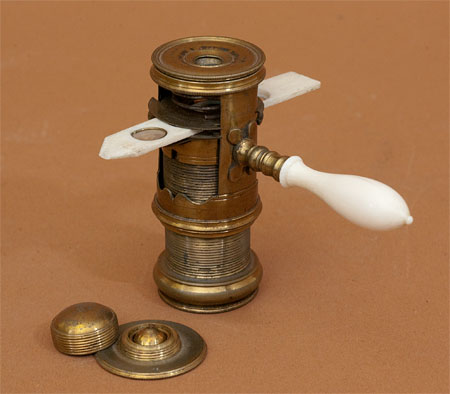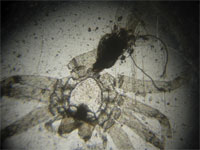 |
|||||
 |
 |
||||
 |
|||||
 |
 |
||||
Wilson Screw-Barrel Microscope (No. 25) |
|||||||||||
| Age: c. 1720 Made by: unknown Made in: possibly France |
|||||||||||
 |
|||||||||||
 |
|||||||||||
 |
|||||||||||
|
Imaging
|
|||||||||||
|
This type of instrument is known as a Wilson screw-barrel microscope. The design shown here, i.e., a single lens instrument with a screw focus mechanism, was invented by Nicolas Hartsoeker possibly as early as 1689, but described in Hartsoeker's Essay de Dioptrique (1694). It was the optical maker, James Wilson (England), however, who published a description of it in 1702 and popularized the instrument. The screw-barrel microscope consists of a small cylinder with an external thread at both ends. The optics consist of an objective lens, in its brass mount, screwed onto one end of the threaded body (top, image above), while a condenser lens for specimen illumination is screwed onto the other end. The sample to be examined is inserted through the opening in the side of the tube and is held in place by a spiral spring within the tube. Focusing is accomplished by screwing the outer tube in or out, which moves the specimen closer or further from the magnifying lens. This is how it is used. In this instrument, a removable ivory handle is attached to the tube and six objective lenses of varying power are included in the small case. It could only be used for transparent objects, such as might be mounted in a slide with a mica covering. Also included is a small glass lens and an auxiliary magnifier for observing opaque objects. A single biconvex lens wrapped in paper is included among the accessories. The label "Lentille" suggests a French origin for this instrument. Accessories included with this instrument are two bone specimen slides, five hand-cut glass slides, a forceps plus black/white disc, and a small hand loupe. The complete set can be stored in a velvet-lined wood case. |
|||||||||||
| Microscope featured 2/04, 3/10, 11/18 | |||||||||||